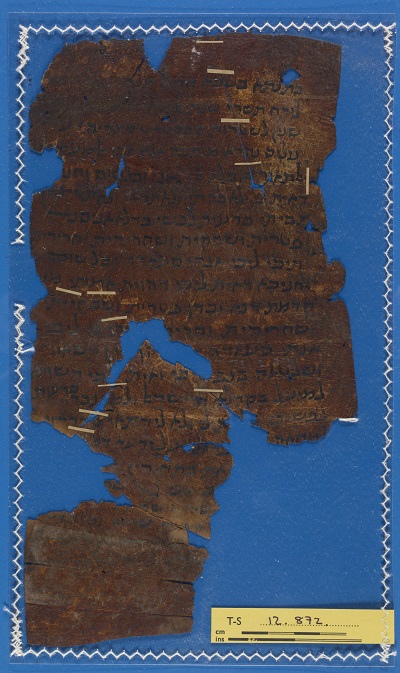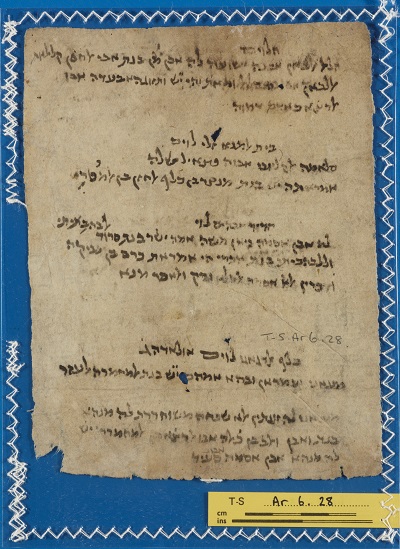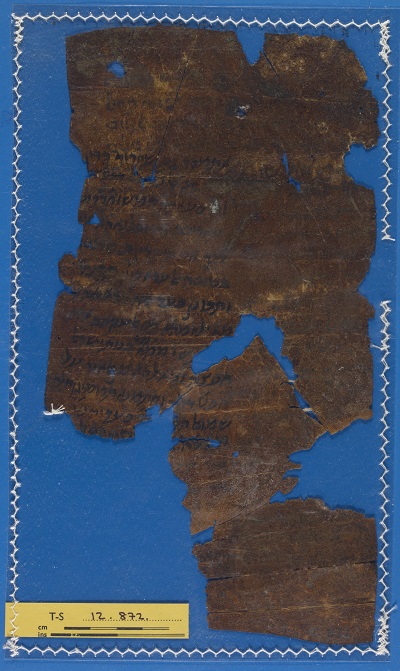Saʿāda the enslaved woman: immersion and oblivion, T-S 12.872
A dark-looking and torn parchment at the Taylor-Schechter Genizah collection (T-S 12.872) contains a bill of manumission of an enslaved woman, around the year 1200 in old Cairo.
T-S 12.872 recto
There are several other such bills in Genizah collections, but this specific fragment sheds light on an interesting case of censorship and social exclusion of emancipated slaves and their offspring. It also includes a unique description of the actual ritual, as well as additional information concerning procedures of conversion and ritual immersion in medieval Cairo.
To better understand the story of our fragment we should first take a look at T-S Ar.6.28.
T-S Ar.6.28 recto
This piece of paper contains several short genealogical lists. One of them, at the bottom of the page, lists the family of Khalaf al-Dajājī, a Levite, and his sons. The first son, Maʿānī, had two wives, according to the list. The first one was ‘a freedwoman’, and ‘she gave him a girl and a boy’. Maʿānī's second wife was his maternal cousin, and ‘she gave him a son, named Abū Saʿīd’. Both wives’ names are not specified, which is not surprising in this context. What is surprising, and quite telling, is how the author of the list fails to mention the name of Maʿānī’s son from his first wife, the freedwoman. Why was this son’s name excluded from the genealogical list? Doesn’t that contradict the whole purpose of such a list? Was there something problematic about him, and is it related to the fact that his mother wasn’t originally Jewish, but an enslaved woman who was converted to Judaism by the process of enslavement and manumission?[1]
Maʿānī was a prominent merchant in the ‘Genizah society’ of Egypt and is mentioned in several documents from the early thirteenth century, from which it is evident that he travelled all the way to India in his commercial ventures. His son Saʿīd, or Abū Saʿīd (it was common to add or omit such prefixes), was also an active and distinguished merchant. He is even mentioned in a testimony from Abraham Maimonides’ court, from 1226, testifying to the death of a fellow merchant in Sumatra.[2] Maʿānī b. Khalaf was, therefore, an important merchant and an esteemed member in the Jewish community of Fustāt, old Cairo. Is it possible that as part of his trade voyages to India, Maʿānī took for himself a slave woman, a concubine for all practical purposes, and later tried to present her as legally manumitted and therefore now a free Jewish woman, and eligible for marriage? The case of Abraham ben Yijū, another ‘India trader’ known from Genizah documents published in the ‘India book’ series by Goitein and Friedman, is an earlier example of similar behavior.[3]
Recently, I was able to identify that an unpublished, untranscribed bill of manumission in the Taylor-Schechter collection was given by one Abū l-Maʿālī ben Khalaf al-Dajājī the Levite, ‘the great merchant’, to his enslaved woman, Saʿāda, probably in 1198, in Fustāt. The date, place and the different components of the owner’s name fit ‘our’ Maʿānī b. Khalaf the Levite from the genealogical list. The only difference in name, Maʿānī vs. Maʿālī, can be easily explained by the closeness of these consonants. If indeed the great merchant Maʿālī b. Khalaf al-Dajājī the Levite from the manumission bill is one and the same with Maʿānī b. Khalaf al-Dajājī the Levite from the genealogical list, it is probable that Saʿāda, the woman emancipated by this bill, was the same freedwoman whom Maʿānī b. Khalaf married, the mother of the anonymous girl and boy. If that is so, it gives a name, date and place to the manumission of Maʿānī’s wife, which was also her de-facto conversion into Judaism.
But beyond our ability to partially reconstruct some details from the life story of an enslaved woman and her forgotten children, it is the reverse side of the torn bill of manumission which adds fascinating information, not only on the circumstances of her own manumission and conversion to Judaism, but on social realities in the Jewish communities of early thirteenth-century Cairo. The reverse side of the parchment contains a testimony that the get, the bill of manumission, was indeed received by Saʿāda from Maʿālī, a testimony which can be found on some other bills of manumission, or divorce. Yet this testimony continues to describe what followed:
and afterwards, we, the court in [Fustāt?] have immersed her in the synagogue of the Irāqiyīn, may it be preserved. And this was done after we have notified her what obligates her… which the daughters of Israel are obligated to keep, and her rewards for doing so.
This precious testimony is, as far as I am aware, the only extant description of an actual ritual of conversion to Judaism in the medieval Islamic Middle East, a conversion of a specific individual in a known date and place. Two or three other descriptions from the Cairo Genizah are much shorter, written retrospectively (perhaps many years later) and are merely a paraphrase of the basic rabbinic requirements – they just succinctly report that the proselyte was circumcised and immersed properly. None of these testimonies concerns a woman, or an enslaved person.[4]
T-S 12.872 verso
What we have here on the reverse of the manumission bill, then, is a rare description of an actual conversion ritual to Judaism, including ritual immersion and notifying the prospective proselyte of the basic commandments which he, or she, must observe, the rewards for doing so, and punishments for failure. It also shows that at least in the specific case of Saʿāda, enslaved persons on the verge of emancipation were considered as proselytes for all practical matters, at least in terms of the applicable ritual. Though prescriptive Jewish legal literature considers emancipated slaves as proselytes, Genizah documents and contemporaneous responsa teach us that many times they were not treated as such.
The mentioning of a ritual immersion is also of interest. As was already pointed out by various scholars, Egyptian Jewish women did not immerse in a ritual bath, but rather went to the Nile, or otherwise washed in a public bathhouse. It was only following the legislating efforts of Maimonides and others that immersion in a mikveh became more established. The reference to an immersion ‘in the synagogue of the Irāqīs’ excludes both options, in my opinion, and points to the existence of a built ritual bath, a mikveh, in that synagogue. A document from 1234 refers to ‘the pool of the Irāqiyīn’, which was understood as a possible ritual bath.[5] The bill discussed here not only confirms the existence of a ritual bath at the site, but also allows us to precede its dating by more than three decades, to the period of Maimonides himself. In fact, one of the judges who witnessed Saʿāda’s emancipation and immersion was one of the signatories on Maimonides’ statute concerning immersion in a mikveh.
To sum up, we have before us a case of the emancipation and conversion to Judaism of an enslaved woman. Supposedly, there should have been no question concerning her proper instruction and conversion: her former master was an esteemed member of the community, she was converted in a public space at the heart of the Jewish neighbourhood of Fustāt, in the Irāqī synagogue, by a court composed of some of the leading judges of the time. She was properly immersed in a ritual bath, after being notified of her obligations as a Jewish woman, and all this was also documented in writing. Nonetheless, it appears that her integration in the Jewish community was not guaranteed. If we assume that Saʿāda was indeed later married to her former master, Maʿānī, and that she is the anonymous ‘freedwoman’ mentioned as his first wife in the genealogical list, it seems that at least for the writer of that list, her Jewish identity was not beyond dispute. It seems that this writer deliberately chose to mention her son only in passing, and to focus instead on Maʿānī’s other son, from his second, originally-Jewish wife. Even the meticulous supervision of her conversion, as documented in the exceptionally detailed bill of manumission, could not help her and her children to remain above suspicion. We can even wonder whether the rare detailing of Saʿāda’s conversion ritual was written in the first place with anticipation of lingering suspicions or claims concerning the validity of her new, Jewish identity.
Footnotes
[1] The document and the questions it raises are discussed by S.D. Goitein in his A Mediterranean Society, vol. 3, pp. 206–7. The list was published and translated to Hebrew by M.A. Friedman in his Jewish Polygyny, pp. 294–296. See also his article ‘Women and the India Trade’ in From Sages to Savants: Studies Presented to Avraham Grossman, Joseph R. Hacker, Yosef Kaplan, B. Z. Kedar (eds), Jerusalem 2010, pp. 170–172.
[2] See Friedman, Women and the India Trade, pp. 163, 168–172.
[3] See S.D. Goitein and M.A. Friedman, India Traders of the Middle Ages: Documents from the Cairo Geniza, Leiden 2008, documents III17 (pp. 632–634) and III29bc (pp. 690–692).
[4] More information on such conversions and their description can be found in Moshe Yagur, ‘Religious Conversion and Communal Boundaries in Geniza Society (10th–13th centuries): Proselytes, Slaves, Apostates’ (PhD dissertation, Hebrew University of Jerusalem, 2017), pp. 16–20, 37–44.
[5] T-S J1.47, edited and translated to English in Moshe Gil, The Documents of the Jewish Pious Foundations from the Cairo Geniza, Leiden 1976, no. 131, d14. And see a discussion on the subject in Goitein, A Mediterranean Society, vol. 2, pp. 154–155, and see now Eve Krakowski’s forthcoming study, ‘Maimonides’ Menstrual Reform in Egypt’.
Cite this article
(2019). Saʿāda the enslaved woman: immersion and oblivion, T-S 12.872. [Genizah Research Unit, Fragment of the Month, August 2019]. https://doi.org/10.17863/CAM.49264
If you enjoyed this Fragment of the Month, you can find others here.
Contact us: genizah@lib.cam.ac.uk



